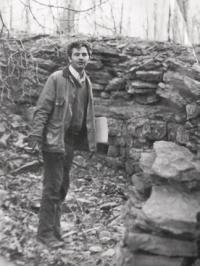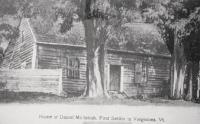
Serving the Vermont Champlain Valley Area for 45 Years
Main SectionsFront Page SportsValley VitalsIt's in the StarsStarwiseArchivesLinksAbout The VoiceContact Us |
Delving Into History: Spending Time With Historian & Raconteur Dick AdamsTuesday August 23, 2011 By Cookie Steponaitis To hear Dick Adams tell the story he was something of a hell raiser when he was a child and so he got sent to spend a lot of time with his grandparents and in particular his grandmother who was one-half Mohawk. While she loved the water she passed on to Dick skills that included basketry and sent him on his first archaeological dig. The site was by an old fencepost on his cousin’s land in an upper meadow, marking the location of an Indian burial ground. While that dig was not productive it sparked a passion in Dick for history, detective work and one for getting into the dirt and piecing together clues from the past that carries to this day. To hear Dick Adams tell the story is just a pure pleasure. He is a repository of local history and archaeology and continues the quest to find out the answers to the past, not because someone else did it first, but because you challenge what is known and piece together records and archaeological finds to create your own understanding of history. “Just because I tell it to you now, don’t believe it,” cautioned Dick Adams. “In fact,” he chuckled, “read history, but don’t believe it until you can prove it right or wrong.” Sitting in his Vergennes home, which is a repository for local history objects; Adams warms to the topic and focuses on his early days in Vergennes when he worked with many local youths to unearth pieces of Addison County’s incredible history. Starting out with the Vermont Archaeological Society in the early 1960’s Adams was chagrined to find the organization more of a social club than a “hands on” archaeology outfit. Living in the midst of Fort Crown Point, Fort William Henry and Fort Ticonderoga on the New York Side and the Otter Creek Basin on the Vermont side, Adams brought together many young men who spent several afternoons digging in the dirt at Rokeby in the early days of researching the Rokeby Kitchens and even taught the group first hand through their own digging of the Macintosh cabin. Known to the locals as the site of the first settler in the Vergennes area, Adams wanted to find out for himself if the historic claims of Macintosh being attacked by Indians, building a palisade and the exact location of the cabin were in fact accurate. Beginning by reading and researching, the group first examined the first historic accounts that were available and set about looking through old maps and city hall records to piece together what was known and then he had them challenge it with the dig.” We were able to confirm the attack by Indians with arrowheads and found the size of the house by the stones for the doorstep, the fireplace and other markings. While we confirmed some, we raised more questions still.” In addition to the group of young men who were a part of the dig, Adams made specific mention of Ruth O’Connor and Bob Mitchell and their roles in decoding, recording and preserving local history. “Some of those boys, well, they aren’t boys anymore,” reflected Adams. “They went on to continue their passion for history. Steve Loreing now works for the Smithsonian and I am working with him right now with a group in Alaska and this remarkable find there, but that is a story for another time and another afternoon,” smiled Adams. “Dennis Hall is still involved as are many, but sadly the passion for archaeology in this area needs to be re-excited,” concluded Adams. Turning to local Elias Baldwin he grinned, “That’s where you and your generation comes in.” Over the course of his career Adams has published, lectured for high school groups and has been in or on the grounds of literally every home, site and place in Addison County related to history. Listening to him recount his work is enlightening, historical fact laced with personal experience and a quick wit. While the interview was designed to touch on one facet of Adams historical passions, it quickly became clear that one leads to another and another. “I have an upcoming project focusing on McDonough, his fortifications and the role of the Battle of Plattsburgh in history. I have read the books, done the research, and even argued with several historians over their interpretations of things, but I have a set of questions that need answering,” stated Adams. He went on to explain that at the time of the battle McDonough had 7,000 troops here, including the Vermont militia. While the Monkton Iron Works was the largest in America at the time and located at the base of the falls in Vergennes, provisions for that army and McDonough’s fleet would have been substantial. In fact, since it was not a forgone conclusion that MacDonough would be successful, there was concern expressed by the Monkton Iron Works of what would happen to them and their workers if he lost. The location of all of the provisions for this battle is one of the missing pieces Adams hopes to provide answers to with digs. With plans to look at MacDonough Point which guards the entrance to the Little Otter, Adams hopes to shed some light on this critical piece of history. “You have to reason that this battle was so successful, yet it has been largely forgotten,” remarked Adams. “At the time of it, our capital city in Washington was in ruins, our president was in exile, the United States Congress was on the run and Jackson and his army were in New Orleans. This was not only important, but critical and what happened here needs looking into.” For the curious and the just plain novice Adams suggests, “… looking into history by first picking up a book and reading. Learn about the local history and then just look at old maps for a start and ask yourself questions. Why is it called Battery Hill? Why is the US arsenal where it is? Why did some families in the middle of Vergennes find cannon balls in their yards when they dug to put in gardens? Why is the foundation of what is now Vergennes Residential Care made of military cut stone? Once you begin asking why, the next step is the research, the investigation and proving, disproving or finding out revelations of history for yourself.” While Adams does not do formal presentations much anymore, people fascinated by his knowledge and experiences are in for a treat. He is collaborating with a local young author to do a book of his stories, research and his never ending quest to spark in the next generation the passion for history, archaeology and probing into the history that makes the Lake Champlain Basin one of the richest historical regions in New England and a pivotal one in the history of our nation. One afternoon spent with this raconteur and a snip of what is stored in the mind, home and heart of a man who eats, sleeps and breathes local history and anyone would be hooked on history and digging literally and figuratively into the past!
|
AdvertisementsSearch our Archives |
Agricultural Weather Forecast:

© 2006-18 The Valley Voice • 656 Exchange St., Middlebury, VT 05753 • 802-388-6366 • 802-388-6368 (fax)
Valleywides: [email protected] • Classifieds: [email protected] • Info: [email protected]


 Printer Friendly
Printer Friendly